How Do Australian Shepherds Handle Being Left Alone In a House With a Bird?
Key Takeaways:
- Australian Shepherds may have a natural herding instinct towards birds.
- Introducing a new Australian Shepherd to a bird should be done gradually and under supervision.
- Proper training and socialization can help Australian Shepherds behave appropriately around birds.
- Each Australian Shepherd’s response to being left alone with a bird may vary and depends on the specific dog’s temperament.
Imagine this scenario: you’re heading out for the day, leaving your home and your beloved Australian Shepherd behind. But this time, there’s a twist.
You’ve recently acquired a new addition to your family – a beautiful bird.
As you close the door, a wave of uncertainty washes over you. Will your Australian Shepherd be able to handle the presence of the bird while you’re away?
As an expert on Australian Shepherds, I’m here to guide you through this unique situation.
In this article, we’ll explore the traits of Australian Shepherds, the challenges of separation anxiety, and provide valuable tips and solutions for leaving your Australian Shepherd alone with a bird. So, let’s dive in and ensure a harmonious household for both your beloved pets!
| Australian Shepherds Alone with a Bird | |
|---|---|
| Characteristic | Description |
| Temperament | Australian Shepherds are generally good with other pets, but their instinct may trigger a herding drive towards birds. |
| Prey Drive | They have a strong prey drive, which means they might be tempted to chase or harm the bird if unsupervised. |
| Socialization | Proper socialization and obedience training can reduce the risk of aggression towards birds. |
| Exercise Needs | Australian Shepherds require high levels of exercise to keep them mentally and physically stimulated, which can help reduce behavioral issues when left alone with a bird. |
| Supervision | It is crucial to closely supervise interactions between Australian Shepherds and birds to ensure the safety of both animals. |
Australian Shepherds: An Overview
Brief History of Australian Shepherds
The Australian Shepherd, despite its name, is not actually from Australia. Its origins can be traced back to the United States, where it was bred and developed.
The breed was favored by shepherds who immigrated to America from Australia in the 1800s.
These shepherds brought their herding dogs along with them, and these dogs eventually became the foundation stock for the Australian Shepherd we know today. The Australian Shepherd’s exact lineage is a bit unclear, as there were many crossbreeds and variations in the early years.
However, it is believed that the breed was developed from a mix of Collies, Border Collies, and other herding breeds.
The breed was highly valued for its intelligence, versatility, and strong work ethic. Australian Shepherds excelled at herding livestock on ranches and farms.
They were known for their agility and ability to handle large flocks of sheep or cattle.
Their herding instincts were honed over generations, making them exceptional at their job. Over time, Australian Shepherds gained popularity beyond the realm of herding.
They became beloved family companions and excelled in various dog sports such as agility, obedience, and flyball.
Their loyal and affectionate nature made them a favorite among dog enthusiasts. Today, Australian Shepherds are cherished pets and active working dogs.
Their rich history as efficient herders and their remarkable intelligence have made them a versatile and well-respected breed.
Whether as a hard-working ranch hand or a loving family member, the Australian Shepherd continues to leave a lasting impression on those who have the pleasure of owning one.

Physical and Behavioral Traits of Australian Shepherds
Australian Shepherds are known for their distinctive physical and behavioral traits. They are medium-sized dogs with a sturdy build and a dense double coat that requires regular grooming.
These dogs are highly active and energetic, requiring plenty of exercise to keep them physically and mentally stimulated.
They excel in various dog sports and activities, including agility and obedience training. In terms of behavior, Australian Shepherds are intelligent and highly trainable.
They are known for their strong work drive and desire to please their owners.
However, they may also display herding instincts and may try to herd other animals or even children. Early socialization and training are important to ensure that they are well-behaved and properly mannered.
Australian Shepherds are known for their loyalty and devotion to their families.
They form strong bonds with their owners and may become anxious or distressed when left alone for long periods. Separation anxiety can be a common issue in this breed, and it is important to address this through proper training and management techniques.
Overall, Australian Shepherds are active, intelligent, and affectionate dogs that thrive on human companionship.
They require an active lifestyle and a lot of mental and physical stimulation to keep them happy and content. With proper training and socialization, they can make excellent companions and family pets.

Understanding Separation Anxiety in Australian Shepherds
What is Separation Anxiety?
Separation anxiety is a common condition in dogs, including Australian Shepherds. It occurs when a dog becomes distressed or anxious when their owner or primary caregiver is not present.
This can lead to destructive behaviors, excessive barking, or even attempts to escape.
Dogs with separation anxiety may also pant, pace, or exhibit other signs of distress. It’s important to address separation anxiety promptly to ensure the well-being of your Australian Shepherd and maintain a harmonious living environment.

Signs of Separation Anxiety in Australian Shepherds
Signs of Separation Anxiety in Australian Shepherds can manifest in various ways. Some common signs include excessive barking or howling, destructive chewing or scratching, pacing or restlessness, urinating or defecating indoors, attempting to escape, and excessive drooling or panting.
Australian Shepherds may also display clingy behavior and become overly attached to their owners, exhibiting signs of distress when left alone.
It’s important to recognize these signs to address the issue and ensure the well-being of your furry friend.
Causes of Separation Anxiety in Australian Shepherds
Separation anxiety in Australian Shepherds can occur due to a variety of reasons. Here are some common causes:
- Lack of socialization: Australian Shepherds that haven’t been properly socialized may develop separation anxiety when left alone. It’s essential to expose them to different people, animals, and environments from an early age.
- Previous traumatic experiences: Dogs that have experienced traumatic events like abandonment or loss of a companion may be more prone to separation anxiety. These past experiences can create fear and insecurity when left alone.
- Overattachment: Australian Shepherds are known to form strong bonds with their owners. If they become excessively attached, they may struggle to cope when their humans are not around.
- Changes in routine or environment: Dogs are creatures of habit, and sudden changes in their routine or living environment can trigger anxiety. Moving to a new house, a family member leaving, or a significant change in the daily schedule can disrupt their sense of security.
- Lack of mental and physical stimulation: Australian Shepherds are intelligent and high-energy dogs. If they don’t receive enough mental and physical exercise, they may develop anxiety and become restless when left alone.
- Lack of training: Proper training helps dogs understand boundaries and builds their confidence. Without clear guidance, Australian Shepherds may feel overwhelmed and anxious when left alone.
Understanding the potential causes of separation anxiety in Australian Shepherds can help you identify the underlying issues and take steps to address them.
Tips for Leaving an Australian Shepherd Alone with a Bird
Introducing the Bird to the Australian Shepherd
Introducing a bird to an Australian Shepherd can be a delicate process. It’s essential to take things slow and ensure the safety and comfort of both animals.
Start by allowing them to get used to each other’s smells and presence through a controlled introduction.
Keep the bird in a secure cage initially, allowing the Australian Shepherd to observe from a distance. Gradually decrease the distance between them while offering positive reinforcement to the dog for calm behavior.
Always supervise their interactions and provide a safe space for the bird to retreat to if needed.
Remember, patience and gradual progress are key when introducing these two animals to each other.
Establishing a Safe and Comfortable Space for the Bird
When it comes to establishing a safe and comfortable space for your bird, there are a few key things to remember. Firstly, make sure that the bird’s cage is secure and sturdy, with no loose or broken parts.
Provide ample space for the bird to move around and stretch its wings.
Additionally, consider placing the cage in a quiet and low-traffic area of your home, away from potential hazards like drafts, direct sunlight, or loud noises. Provide appropriate perches, toys, and food and water dishes within the cage.
Regularly clean and maintain the cage to ensure a healthy environment for your bird.
Lastly, consider providing a comfortable and cozy area outside of the cage where your bird can safely explore and play under your supervision. By incorporating these tips, you can create a safe and comfortable space for your bird to thrive in your home.
Mentally and Physically Stimulating the Australian Shepherd
Mentally and physically stimulating the Australian Shepherd is essential to keep them happy and well-balanced. Here are some ways to engage their active minds and bodies:
- Provide daily exercise: Australian Shepherds are full of energy and need plenty of physical activity. Regular walks, runs, or playtime in a secure, fenced area will help burn off their excess energy and prevent boredom.
- Engage in interactive play: Interactive toys, such as puzzle feeders or treat-dispensing toys, can keep your Australian Shepherd mentally stimulated. These toys require problem-solving skills and keep them entertained for extended periods.
- Teach new tricks: Australian Shepherds are highly intelligent and enjoy learning new things. Teach them tricks, obedience commands, or even agility training. This not only engages their minds but also strengthens the bond between you and your furry friend.
- Provide mental enrichment: Engage their minds with mental enrichment activities, like scent work or hide and seek games. This taps into their natural herding instincts and gives them a sense of purpose.
- Rotate toys: Keep your Australian Shepherd’s toys fresh and interesting by rotating them regularly. This prevents them from becoming bored with the same toys and keeps their minds active and engaged.
Remember, Australian Shepherds thrive when they have both mental and physical stimulation. Incorporating these activities into their daily routine will help prevent behavioral issues and ensure a happy and fulfilled pup.
Using Positive Reinforcement and Training Techniques
Using positive reinforcement and training techniques is essential when leaving an Australian Shepherd alone with a bird. I always recommend using positive reinforcement methods such as rewards and treats to reinforce desired behaviors.
This can include giving your dog a treat when they remain calm and well-behaved around the bird, or when they follow a command to “leave it” or “stay.” By associating positive experiences and rewards with these behaviors, you can help your Australian Shepherd develop positive associations and habits.
In addition to positive reinforcement, it’s important to utilize training techniques that help establish boundaries and control. Teach your Australian Shepherd basic obedience commands such as “sit,” “stay,” and “leave it.” This will give you a way to redirect their attention or maintain control in situations where their instinct to chase or play with the bird may arise.
Consistency is key when training, so be sure to practice these commands regularly and reinforce them with positive reinforcement.
Another effective training technique is desensitization. Gradually introduce your Australian Shepherd to the presence of the bird in a controlled and supervised manner.
Start by having the bird in a separate cage or enclosed area where the dog can observe, but not interact directly.
Gradually increase exposure and reward your dog for calm behavior around the bird. This process may take time, so be patient and go at your dog’s pace.
Remember, every dog is unique, so what works for one Australian Shepherd may not work for another.
Pay attention to your dog’s individual needs and reactions, and adjust your training techniques accordingly. Consulting a professional dog trainer can also be beneficial in developing a training plan tailored to your specific situation.
By using positive reinforcement and training techniques, you can help your Australian Shepherd develop good habits and a positive relationship with the bird.
With time, patience, and consistency, they can learn to coexist peacefully and safely in the same space.
Management and Precautions for Australian Shepherds and Birds
Proper Supervision and Monitoring
Proper supervision and monitoring are essential when leaving an Australian Shepherd alone with a bird. It’s important to keep a close eye on both the dog and bird to ensure their safety.
I recommend constantly monitoring their interactions, especially during the initial stages of introduction.
By staying vigilant, you can intervene if any aggressive behavior or unwanted interactions occur. Regularly checking on them will also help you identify any signs of stress or anxiety in your Australian Shepherd.
Remember, it’s crucial to provide a safe and controlled environment for both the dog and bird.
Ensuring the Safety of the Bird
Ensuring the safety of the bird when left alone with an Australian Shepherd is important. Here’s how you can do it:
- Provide a secure enclosure or cage for the bird: Make sure the bird has a safe and secure space where it can retreat to when needed. The enclosure should be escape-proof and sturdy.
- Separate the bird from the dog: Keep the bird in a separate room or use barriers to prevent direct contact between the dog and the bird. This will minimize the risk of any potential harm to the bird.
- Supervise interactions: When the dog and bird are in the same room, always keep a close eye on their interactions. Intervene immediately if you notice any signs of aggression or rough behavior from the dog.
- Train the dog: Properly train your Australian Shepherd to have good manners and impulse control around the bird. Teach basic commands such as “leave it” and “stay” to deter any unwanted behavior towards the bird.
- Provide mental and physical stimulation: Ensure that your Australian Shepherd is mentally and physically stimulated to prevent boredom and potential destructive behavior. Provide toys, puzzles, and regular exercise to keep them occupied.
- Seek professional help if needed: If you’re unsure about how to manage the situation or if your Australian Shepherd shows signs of aggression towards the bird, consult with a professional dog trainer or behaviorist for guidance.
Remember, every dog is different, so observe their behavior and make adjustments as necessary to ensure the safety and well-being of both the dog and the bird.
Creating a Routine and Consistency for the Australian Shepherd
Creating a routine and consistency for your Australian Shepherd is essential to help them adjust to being left alone in a house with a bird. Dogs thrive on structure and predictability, so establishing a regular schedule can help alleviate their anxiety and provide them with a sense of stability.
Start by setting consistent feeding and exercise times for your Australian Shepherd.
This will not only help them get into a routine but also ensure they are physically and mentally stimulated before being left alone with the bird. A tired Aussie is generally a well-behaved Aussie! Incorporate training sessions into your daily routine.
Australian Shepherds are highly intelligent and need mental stimulation to prevent boredom.
Teach them basic obedience commands and provide them with interactive toys or puzzles to keep their minds engaged. Create a designated safe space for your Australian Shepherd to retreat to when they are alone.
This can be a crate or a specific room where they feel secure and comfortable.
Make sure this space is free from any potential hazards or objects that could harm the bird. When leaving your Australian Shepherd alone with the bird, provide them with distractions to keep them occupied.
Toys, chew bones, or treat-dispensing puzzles can help redirect their attention away from the bird and prevent them from becoming overly fixated.
Consistency is key when it comes to managing your Australian Shepherd’s behavior. Stick to the established routine and avoid deviating from it too often.
Dogs thrive on predictability, so maintaining a consistent schedule will help them feel secure and reduce the chances of them becoming anxious or stressed.
Remember, every dog is different, and what works for one Australian Shepherd may not work for another. It’s important to observe your dog’s behavior and make adjustments to the routine as needed.
And if you’re ever unsure or need additional guidance, don’t hesitate to seek advice from a professional dog trainer or behaviorist.
They can provide personalized recommendations tailored to your specific situation.
Seeking Professional Help and Consultation if Needed
If you find that your Australian Shepherd is struggling with being left alone in a house with a bird, seeking professional help and consultation can be a valuable step. It’s important to recognize that each dog is unique, and some may require additional support or guidance in handling this situation.
A professional dog trainer or behaviorist can work with you and your Australian Shepherd to develop a personalized plan to address any issues or concerns.
They have the expertise and experience to assess your dog’s behavior, identify any underlying causes or triggers, and provide effective strategies for managing and reducing separation anxiety. Additionally, consulting with a veterinarian can also be beneficial.
They can rule out any potential medical conditions that may be contributing to your dog’s distress or anxiety.
They may also offer recommendations for medications or supplements that can help alleviate your dog’s anxiety and improve their overall well-being. Remember, seeking professional help doesn’t mean there is something wrong with your dog or that you’re a bad owner.
It simply means that you are committed to providing the best care and support for your Australian Shepherd.
Professional guidance can help you better understand your dog’s behavior and offer effective solutions to ensure a harmonious environment for both your dog and the bird.
Finding Alternative Solutions for Australian Shepherds and Birds
Hiring a Pet Sitter or Dog Walker
If you’re worried about leaving your Australian Shepherd alone with a bird, hiring a pet sitter or dog walker can be a great solution. These professionals can provide companionship and exercise for your dog while ensuring the safety of the bird.
A pet sitter can come to your home and spend time with your Aussie, giving them attention and playtime.
A dog walker can take your dog for regular walks, which helps them burn off energy and stay mentally stimulated. This not only alleviates boredom but also reduces the chances of any destructive behavior.
When hiring a pet sitter or dog walker, make sure to choose someone who has experience with both dogs and birds.
They should be knowledgeable about the specific needs and behaviors of both species. Consider asking for recommendations from friends or fellow pet owners, or search for professionals in your area who specialize in caring for dogs and birds.
By hiring a pet sitter or dog walker, you can have peace of mind knowing that your Australian Shepherd is safe and entertained, while the bird is also well-protected.
Interactive Toys and Puzzles for the Australian Shepherd
Interactive toys and puzzles can be a great way to keep Australian Shepherds mentally and physically stimulated when they are left alone in the house with a bird. These toys provide entertainment and a challenge for your dog, which can help prevent destructive behaviors caused by boredom or anxiety.
There are a variety of interactive toys and puzzles available for Australian Shepherds.
Treat-dispensing toys are a popular choice, as they require the dog to figure out how to release the treats. This can keep them occupied for extended periods and provide a rewarding experience.
Puzzle toys with hidden compartments or sliders are also great options, as they require problem-solving skills and keep the dog engaged.
It’s important to choose toys and puzzles that are appropriate for your dog’s size and skill level. Some toys may be too challenging, leading to frustration, while others may be too easy and quickly lose their appeal.
Experiment with different toys to find what works best for your Australian Shepherd.
Interactive toys and puzzles can be used as part of a routine when leaving your Australian Shepherd alone with a bird. By rotating different toys and puzzles, you can keep your dog engaged and prevent them from becoming bored or anxious.
Additionally, these toys can provide mental stimulation and help tire out your dog, making them more likely to rest and relax while you are away.
Remember to supervise your dog when they are playing with interactive toys, especially if they contain small or removable parts that could be a choking hazard. Regularly inspect the toys for any signs of wear or damage and replace them as needed.
Training Classes and Socialization for the Australian Shepherd
Training classes and socialization are essential for Australian Shepherds. They help the breed to develop good behavior and manners, as well as enhance their social skills.
Training classes provide structured guidance and teach obedience commands, while socialization exposes them to different environments, people, and animals.
This helps prevent behavioral issues and makes the dogs well-rounded and adaptable. It’s important to enroll your Australian Shepherd in training classes from a young age and continue socializing them throughout their life.
This will ensure they grow up to be well-behaved and confident dogs.
Considering the Option of Rehoming or Finding a New Home for the Bird
Considering the Option of Rehoming or Finding a New Home for the Bird: If you find that your Australian Shepherd and bird cannot coexist peacefully or that the stress of separation becomes too overwhelming, you may need to consider rehoming the bird or finding it a new home. While it can be difficult to part with a companion, it’s important to prioritize the well-being and safety of both your dog and the bird.
Rehoming the bird involves finding a new responsible owner who can provide a suitable environment and care for it.
You can try reaching out to local bird rescue organizations, pet adoption websites, or even social media platforms to find potential adopters. Ensure that the new owner has experience with birds and is willing to provide the necessary attention and care.
Alternatively, finding a new home for the bird within your own network or among friends and family members who are willing and able to care for it can also be a viable option.
It’s essential to thoroughly vet potential adopters to ensure that they have the knowledge, resources, and commitment to provide a safe and nurturing environment for the bird. Remember, the decision to rehome a pet should not be taken lightly, and it’s crucial to exhaust all other options before considering this step.
If rehoming is the best solution for the well-being of both the dog and the bird, take the time to find a suitable home where the bird can thrive and receive the care it needs.
Final Verdict
Australian Shepherds can indeed be left alone in a house with a bird, but it requires careful management and precautions. Understanding separation anxiety is key, as it can exacerbate behavioral issues.
Introducing the bird properly, creating a safe space, and keeping the Aussie mentally and physically stimulated are crucial.
Positive reinforcement and training techniques can also help. Proper supervision, consistency, and routine are essential, and seeking professional help if necessary is advised.
However, alternative solutions such as hiring a pet sitter or considering rehoming could also be considered.
Overall, with the right approach, Australian Shepherds and birds can coexist peacefully.







